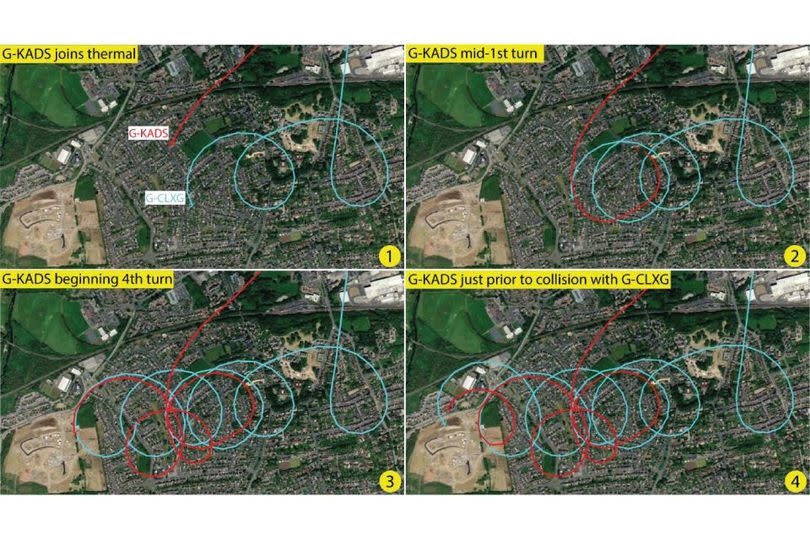Leicestershire glider crash was 'not survivable' investigation reveals

A glider "struck the ground at high speed" in an impact that was "not survivable" following a mid-air crash during a competition, a government body has said. A 67-year-old man died in the incident, in August last year, after the aircraft he was piloting slammed into a field next to a Melton Mowbray housing estate. The 78-year-old pilot of the other glider involved landed safely.
A report published today by the government's Air Accidents Investigation Branch (AAIB) has revealed what happened in the accident, which took place during a multi-day competition held at Husbands Bosworth gliding centre. The report identifies the two vehicles by their registrations: G-KADS is the glider which crashed; and G-CLXG is the aircraft which landed safely.
The AAIB says the accident happened when both gliders were in a thermal – an upward current of warm air used by glider pilots to gain height – with G-CLXG entering the thermal first, and G-KADS following two minutes later. While in the thermal, the pilot of G-KADS "turned inside" G-CLXG’s path, reducing the distance between the two.
READ MORE: Tragic four-vehicle crash in car wash left mum with fractured spine
“It is not possible to know why the pilot of G-KADS did this, or if he lost sight of the other glider before doing so,” the report reads. “This, combined with the pilot of G-CLXG starting to reduce his bank angle to leave the thermal, brought the gliders into conflict and the collision occurred.”
Describing both pilots as having "significant experience in gliding and fixed wing flying", the report states that "both had flown numerous competitions before and had operated in many different environments". The competition was taking place over a number of days with different routes for competitors set every day. On the day of the crash, the gliders were to travel a route to the north of Melton, before turning and heading south to Oxford.
The report states that it is not unusual for several gliders to be entering and climbing the same thermals during a competition. But British Gliding Association protocols state that when entering a thermal, pilots should "retain continual visual contact with other aircraft", adding that "established gliders have the right of way". “The protocol is clear that pilots should never turn inside another glider whilst in a thermal as to do so risks both gliders losing sight of each other and increases the risk of a collision," the report reads. "In this accident, the separation between the gliders reduced due to G-KADS turning inside G-CLXG.”
A witness on the ground who saw the collision reported that one glider seemed to be above the other, but they were both turning left. They described hearing an "almighty bang". The report states: "The witness described that the tail of G-KADS came off immediately and fell straight down with the aircraft then tumbling forward, nose first. The witness lost sight of G-KADS as it descended.”
Following the collision, G-KADS "struck the ground at high speed", with the report adding: “The impact was not survivable, and the glider was destroyed.” The other glider landed in a field more than a mile from where G-KADS crashed, and was said to be "mostly intact".
Although both pilots were wearing parachutes, the pilot of G-KADS had not attempted to jettison the glider’s canopy, with the report stating: “It is possible that the pilot was rendered unconscious by the collision or that the forces on him due to the motion of the glider once it lost its tail meant he could not make any attempt to abandon the aircraft before it struck the ground. The time between the collision and G-KADS striking the ground was around 18 seconds.”
Investigators reassembled the parts of the G-KADS’ fuselage, which revealed the other glider had struck it from below "in an upwards direction". Both aircraft were fitted with electronic transceivers warning pilots of potential collisions, but pilots can adjust the settings and can cancel or mute warnings for up to a minute. While the investigation showed the pilot of G-CLXG had not adjusted the factory settings, it was not possible to establish what settings had been used by the pilot of G-KADS.
The BGA has since taken action to raise awareness of the increased risk of midair collisions in gliding competitions, and has updated guidance on the subject on its website. It will also deliver a safety campaign on the subject this year and is monitoring the International Gliding Commission’s evaluation of a "proximity monitoring tool" that might help with post-flight safety debriefs in UK gliding competitions.
Try the new Leicestershire Live premium app experience for free and read our content with no ads

 Yahoo News
Yahoo News 
